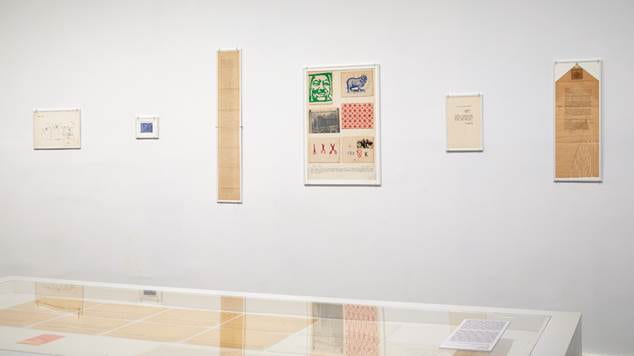By Natalia Gonzalez Blanco Serrano ’24
This summer, the Libraries sent more than 40 rare items and 14 facsimiles to the Museo Nacional Centro de Arte Reina Sofía in Madrid to appear in a major exhibition about the Fluxus art movement of the ’60s and ’70s. “Call It Something Else: Something Else Press, Inc. (1963-1974)” is on display at the internationally renowned museum through Jan. 22.
“Fluxus refers to intermedia artworks that included dance, music, visual art, light shows, and spoken word,” said Music Library curator Greg MacAyeal. “It culminated in the idea of ‘a happening,’ which was like a performance piece that would include different kinds of styles of artwork and expression, and maybe even include some audience participation.”
Northwestern’s Fluxus-centered Dick Higgins Archive, held by the Charles Deering McCormick Library of Special Collections and University Archives, contains many of the items loaned to the exhibit. Higgins himself was an artist, composer, and writer, and is considered a co-founder of Fluxus. Vital to the spread of Fluxus ideas was the Something Else Press, which Higgins created in 1963. It published and distributed important intermedia texts and art, including pieces from contemporary artists such as John Cage, Ray Johnson, and Alison Knowles, and from earlier influences such as author Gertrude Stein.

Objects from Northwestern’s Dick Higgins Archive on display as part of the exhibition “Call it Something Else.” (courtesy Museo Reina Sofia)
The Dick Higgins Archive is one of two significant Higgins archives — the other can be found at the Getty Research Institute in Los Angeles. Northwestern Libraries continues to acquire Fluxus related items and archives, including the yet-unprocessed archives of Fluxus artists Philip Corner, Geoffrey Hendricks, and photographer Peter Moore.
“Our Dick Higgins archive was a gift to us from his daughters Hannah and Jessica. It’s a treasure we are so grateful and proud to have. To have material from it exhibited at a large museum like the Reina Sofia is a delight,” said Scott Krafft, chief curator of Special Collections. “Fluxus was a very international art movement and now in a parallel way our items are traveling the globe.”
The Libraries also contributed items from the John Cage Collection, which includes the John Cage Notations Project collection. Notations is a large collection of scores that represent the evolution of musical notation as a practice and process; the final outcome of it was a book published Something Else Press, MacAyeal said.
The Reina Sofia materials required an enormous amount of work to prepare for shipping and display, said chief conservator Susan Russick.
“Often industrially produced papers are not as long-lasting as handmade, rag papers,” she said. “Fluxus artists emphasized the ephemeral in their works and that sometimes meant using cheaper, lower quality materials that age more rapidly.”
In some cases, such as with fluorescent DayGlo materials that fade easily, a facsimile was the safest way to put paper objects on display without sustaining damage. All objects received proper mounting to simplify their handling and display in Madrid.
Preparing for such a major exhibition requires years of preparation and partnership. “Even the facsimiles for this loan were complicated,” Russick said. “Many of the artists are still living or have works that involve copyright permissions, which needed to be coordinated between multiple entities.”
MacAyeal and other curators are proud to have pulled off this enormous loan after the original plans were disrupted by the pandemic. Now that it’s finally on display, Northwestern has its name plastered on international walls, which is no small feat.
“Having us be such a big part of this international exhibit shows that we are becoming a well-known repository for this kind of material,” MacAyeal said. “We’re happy to be a part of it because it solidifies us as an important place for having these items.”
Natalia Gonzalez Blanco Serrano is a Medill School of Journalism senior
